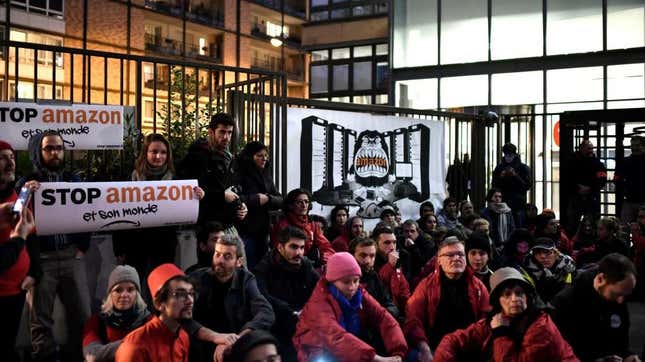
“If we don’t get it, shut it down” is a staple call-and-response of worker protests for good reason. Even without a clear antecedent, the meaning is obvious to bosses: these are out demands. Meet them, or you may find the usual means of extracting profit difficult. This week, Amazon saw the outcomes it set itself up for.
At DIF4, an Amazon warehouse in the exurbs of Paris, workers already in active strikes escalated a step further against a company known worldwide for its brutal job conditions. In conjunction with a local arm of Confédération Générale du Travail (CGT), one of the largest and oldest trade unions in France, workers shut off power to the facility. According to Le Parisien, the electrical box for DIF4 was intentionally tampered with, cutting it off from the grid for a full eight hours and forcing a line of unfilled Amazon trucks to stretch out to the highway. Power eventually was restored by utility company Enedis around 7:30 a.m. local time on Monday.
Closer to home, workers at MSP1—a massive fulfillment center outside Minneapolis and the site of the most vocal Amazon workers in the U.S.—won an important concession from management: a safety council led by workers themselves. Reports from Gizmodo and Reveal recently proved not only the anecdotal evidence of staggering injuries in Amazon facilities, but made clear that company leadership was fully aware these complaints were valid. The injury rate ate MSP1 in 2018, for example, was about triple the industry average for warehouse work.
“The claims are simply not true—we’ve always had a site safety committee, any associate can join and this is communicated directly to associates,” Kelly Cheeseman, an Amazon spokesperson told Gizmodo. She also pushed back on general claims regarding higher rates of injury during the holidays. “it’s incorrect to assert that the holiday season brings higher rates of injuries. It’s not about anyone working faster than they did previously; it’s about processes and our overall operations network coming together to support our teams. At Amazon at this time of year, the number of associates and hours worked increases significantly but so do the amount of leadership, safety staff and support across our teams. As a result, the average rate of injury per person has historically decreased or remained stable.”
MSP1's claimed victory comes after a year and a half of rallies and walkouts by fulfillment center workers in coordination with Awood Center, a community organization for the betterment of Minneapolis’s sizable East African population. Hundreds of workers, activists, and union sympathizers marched on MSP1 this time last year, and its impact has carried over into actions at other warehouses in Amazon’s vast network.
Amazon has been largely unwilling to reckon with the seriousness of the situation in their facilities. In short, they don’t get it. Which only leaves workers with one option.
Updated with comment from Amazon